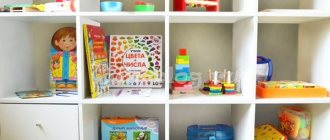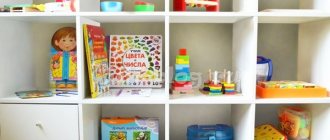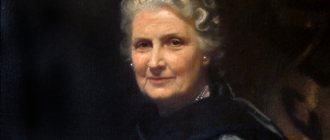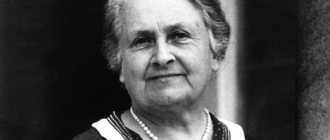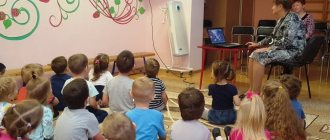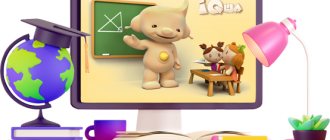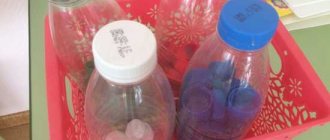Various methods of early development of children are popular among modern parents. But since the main activity for children is play, many of the systems are built accordingly, in particular, Montessori games. The author, Maria Montessori, offers not just a theoretical approach, but also specific options for educational fun for children aged 2-4 years. We invite you to get to know some of them.
Didactic and educational games according to the Montessori system
Montessori games for children are built on the principle of complete independence. Children choose their own materials, pace and rhythms of play. If a child gets bored with one activity, he can change the environment and material at any time. The most important feature is considered to be the right to choose the direction in which the baby would like to develop.
The principle of the Montessori system
The task of parents and teachers is to create a large subject environment. All elements that a child can use to play must be accessible. Educators must respect choice. The goals of education are to create the most comfortable environment in which full development will take place. The child should act both as an observer and as an assistant, if necessary. You can’t strive to make your baby like you. Montessori believes that it is unacceptable to interfere with the process of personality development.
Note! The goals of an adult during a lesson using the Montessori method are to help the child in an effort to develop his independence, to give hints only at the moment when he asks for it. It is strictly forbidden to force a child to do anything.
What are they and what are they aimed at
In the process of developing her methodology, Maria Montessori spent a long time observing the behavior of children in play. Due to this, classes are divided into different areas:
- Mathematical, aimed at developing mental abilities.
- Language to develop communication and cognitive skills.
- Sensory, designed to develop senses of vivid perception of the environment.
- Exercises aimed at developing practical and everyday skills.
- Space so that a child can find his own place in this world.
The purpose of Montessori didactic games is to help children and their spiritual and mental development. The child needs to choose such didactic material on which he will fully concentrate. All aids should be kept as simple as possible, as adult intervention is not recommended. That is, conditions must be created for the child under which he will not only be able to find the mistake himself, but also correct it.
Principles of working with didactic material:
- All elements for games should be located at eye level. This will encourage the child to be active.
- Use of the material is possible only after the parent explains its purpose.
- The work should be carried out in stages, from simple techniques to more complex ones.
- A child can work with material not only according to the principle established by an adult. He can independently apply knowledge.
- It is important to teach your child that after completing each lesson, he himself returns the material to its place. Only after this can he begin another game.
- The elements are laid out in a certain order in front of the baby on a rug or table.
Note! If group classes are held, then one child should work with one material; there should be no transfer of elements from hand to hand to another participant.
Didactic elements
Montessori for children 3-4-5 years old
After three years, children are already fully interested in writing and reading, and although many parents believe that they first need to learn to read, and only then write, in reality this is not so, and often it is easier for a child to start with writing and, with familiar letters, go into the world of reading .
In addition to classes for the development of verbal skills, Maria Montessori's games for this age include classes for mastering the laws of mathematics, expanding one's horizons and knowledge about the world, mastering the most complex everyday skills, developing an ear for music and creative skills.
- By the age of 4, you can demonstrate the first Montessori materials in mathematics, show the child how the number and number of elements relate,
- Writing on unusual surfaces and unusual materials is very exciting for kids: you can write on individual sticks, assemble them into letters and even words. A little later you can write on the board: remember, it is important for a child to always be able to quickly correct a mistake,
- Phonetic hearing is another important area of development for a grown-up child: invite your child to correlate the first letter of a word and an object, sort objects according to their first letter, play making words from letters on magnets or just cards, clearly pronouncing each sound,
- To develop your horizons, decks of cards on different topics (for example, animals, plants, clothes, seasons, etc.) can be useful. Create pairs of them, sort them according to different criteria and develop your baby’s knowledge about the world around them,
- Exercises for physical development should not be neglected either: it is still important for the child to move a lot and learn new gymnastic exercises and games, develop coordination and motor skills. Ball games and complicated tasks from previous age periods are suitable here.
The rapid acquisition of new knowledge about the world around us is very typical for children 3-5 years old. Montessori games for children of this age are designed to quench this thirst for knowledge. Cut out numbers, letters and shapes, check the first letters of words, learn how to classify different objects, develop expanded speech and follow your child's interests.
A whole group of games with magic bags can be a good exercise for developing speech, counting skills and sensory development. You can put objects with different textures, sizes and purposes in a bag and give tasks to determine what it is, count how many objects are in the bag, get an object for a certain letter, and so on.
Sent for sorting
Games focused on the sorting principle are aimed at developing visual skills and help train other organs. As a game activity you can offer:
- Sorting items from 2 to 5 years old. It can be both in shape and color. The lesson develops attentiveness and logic. For the activity you need to take several sets of objects according to size, shape and color. Playing with buttons has a good effect on development. You need to take a large number of buttons, in which there will be five or six identical ones. Mix all the buttons in a bowl, then show your child which type to choose.
- An excellent activity for sensory development is wooden cubes of various sizes. You can buy cubes that are inserted into each other, like a nesting doll.
- A pyramid would be a good activity for children aged two years and older. It can be of any type, but the principle is the same. Such a toy should have one rod and a set of elements. The child's task is to find identical shapes, for example, circles.
- You can choose simple puzzles as a sorting game. In the Montessori method, wooden ones with beautiful pictures are selected. For children under four years old, you should choose puzzles in which each element has a handle to make it easy to hold. It is recommended to avoid cardboard frames.
Pyramid game
Montessori games 2-3 years
By the age of three, the first phase of a child’s development is completed, when he absorbs literally everything that surrounds him. The baby can already do a lot on his own, but some things are still difficult; here you should monitor the successes and interests of a particular child. In the period between 2 and 3 years, Montessori education continues to focus on sensory development, improving motor skills, and also in full swing the development of speech and gaining everyday independence. From about 2 years old, children begin to be interested in letters and numbers, an interest in which should also not be ignored.
- After mastering the basic colors, you can continue to study light and dark shades; games with homemade and purchased Montessori materials will help here: inserts with different shades, gnomes and barrels, colored tablets,
- Preparing your hand for writing may include using tweezers to sort pompoms, playing with clothespins, playing archaeologist using a basin filled with sand or cereal,
- Children of this age play well with buttons, zippers, Velcro and other fasteners. You can create a whole business board
- Playing with water and washing various objects can be unexpectedly exciting activities for two-year-olds: wash vegetables, wipe the table and floor, pour water into different containers and use food coloring to color it,
- Use the possibilities of children's creativity: show your baby different materials and tools, draw with sponges and autumn leaves, paint together eggs, stones and your own body parts
- Cooking together is also far from the last place among Montessori developments. You can start at an earlier age: wash vegetables, peel eggs, mix ingredients and knead dough. Closer to three years, you can show how to cut soft foods (banana, boiled egg or potatoes) using a not too sharp knife. The kid will definitely be delighted with such culinary master classes!
Be sure to include children in the cooking process: the kitchen is a real treasure trove of materials for educational Montessori games for 3 years old. You need to boil potatoes - ask your little helper to pour the required amount of water from the basin into the pan. You need to make a salad - you already know who will wash the vegetables and pick the greens. The most important task in creating a sandwich can also be entrusted to the baby, and in the process of preparing the vinaigrette, you can paint the potatoes with beet juice. In addition, you can sort cereals, play with a sieve, or try pushing something through a garlic press. Overall, if you're looking for Montessori-inspired activities to keep your little one busy, just head into the kitchen together.
Matching games
Matching games are the most popular Montessori activities for ages 1 to 3. The main types are:
- Activities with colors - you can offer your child a cardboard circle with multi-colored sectors and clothespins of the same shades. The child must independently choose his own clothespin for each sector.
- The game can be combined with the help of mom. For example, invite your child to sort washed socks into pairs.
Studying geometric shapes in classes in groups of preschool educational institutions
This group of classes develops logic and attention.
Games with colors
Creating a nurturing Montessori environment at home
Since in the Montessori system the primary role is played by the conditions for unlocking the child’s potential (and not the imposition of ready-made templates), the role of the developmental environment increases. In a child’s nursery, it is advisable to highlight several key areas of development:
- Practical activity area. Its task is to instill self-service skills and perform simple household functions. Functional toys are placed here: dishes, cleaning items (preferably real, not toy ones - sponges, rags, brushes, etc.), aids with buttons, snaps, zippers, lacing, etc.
- Zone of sensory development. These are various small objects, puzzles, boxes of cereals, sensory bags, insert molds, sets of geometric shapes of different shapes, sizes, colors, musical instruments, hammers, jars with aromatic substances, scraps of fabrics of different textures, lacing, etc. In general, there are objects for the development of the senses. In general, Montessori paid special attention to the development of touch and fine motor skills, believing that it was precisely precise actions with small objects that improved thinking, speech, memory, and attention.
- Native language zone. Here children learn letters, learn to read, prepare to master writing skills, and develop sound perception. The filling of the zone will be appropriate: cards with rough (velvet paper) letters, syllables and whole words, just figures of letters, their stencils for tracing, semolina with a tray (on which the child will write letters), etc.
- Math zone. Here there are boxes with numbers (cards and three-dimensional figures), signs for mastering the operations of addition, subtraction, multiplication and division, barbells, spindles, Seguin boards, a set of gold beads, etc. Moreover, it is not necessary that the preschooler master all mathematical operations (especially multiplication and division): it all depends on his enthusiasm and individual pace of development.
- Natural science or space zone. Here the child gets acquainted with the world around him (including the universe), learns to classify living and inanimate nature, and learns the relationships and patterns in it. The child will have the opportunity to conduct real experiments: for example, make sure that a tree burns and a stone sinks in water, build a mini-volcano that will erupt, etc. In the zone there are various cards with images of plants, animals, posters on the human structure, a globe , world maps, models of planets of the solar system, etc., materials for experiments.
- Area of development of gross motor skills, or motor. It is located away from other areas and contains sports equipment.
It is clear that at home (especially if the children's room is small) it is often unrealistic to arrange all these areas, but try to at least allocate separate shelves, for example, in a rack for each group of benefits.
Photo gallery: rooms for small children, decorated according to Montessori conditions
The nursery has a wonderful corner for developing gross motor skills.
Even a blanket on the bed provides an opportunity for sensory development
Such a wardrobe from an early age teaches the child to be independent and develop self-care skills.
The parents' task is to periodically change the contents of the upper and lower shelves so that the child can choose his own study aids
Classes using the Montessori method using sequences of actions
Montessori games are aimed at the ability to determine the sequence of actions. This helps the development of logical thinking. Such classes are successfully used not only for young children, but also for preparatory groups of kindergarten and primary school students. For younger and middle-aged children, an excellent game option would be to show the fairy tale “Kolobok”, in which the child will be able to correctly tell the sequence.
You can suggest a game of cylinder blocks. During the process, the child must arrange objects in the correct sequence. For this purpose, blocks and cylinders with holes are used, which are strung on the structure.
Action Sequence Development
Montessori games for up to one year
In the first months of life, it is very important to provide the baby with a variety of sensory stimuli and freedom to master movements. Despite the ambitious goals, providing your baby with everything he needs may be easier than you think, because Maria Montessori's games always focus on the quality of the material, and not on its quantity or cost.
Montessori children's
For a family expecting a baby, it is important to think about how the room or part of the room for the baby will be decorated. Montessori teachers recommend considering the following functional areas:
- Place to sleep: a fairly wide floor mattress about 10 centimeters high, on which the child can move freely and move around as he gets older, a Moses basket for sleeping in the first couple of months. The sleeping area can be supplemented with soft pillows and carpets so that the growing baby can safely explore the boundaries of his mattress.
- Place for cleaning: cabinet, small table, chair, basket for dirty laundry
- An area with Montessori toys for children up to one year: a low stable shelf, rattles, a safe mirror, mobiles, a wooden ring with an elastic band, a little later simple and safe household items, boxes with holes and balls, inserts and sorters
In all areas accessible to the child, it is necessary to ensure safety: fence sockets, stairs, and remove unstable objects closer to the age of one year.
Goals and ideas for Montessori games
Montessori games up to one year of age should focus on the following tasks: development of sensory organs, formation of targeted grasping, comprehension of the basics of manipulating objects, general physical development and preparation for walking. By the end of 1 year, logical puzzles are already clearly visible in Montessori games.
Babies are born only with the skill of separating light from dark, and in order to achieve “normal” vision they have a lot of work to do. As for interaction with objects, despite the innateness of the grasping movement, Montessori teachers note that the baby learns to purposefully grab objects and move them only 3-5 months after birth.
- Use simple pictures with black silhouettes on a white background: fix them in different corners of the room and periodically change the location and the pictures themselves.
- You can also attach pictures to a long stick and slowly move them in front of your baby’s face so that he learns to focus and follow moving objects.
- With age, you can use pictures with different colors and shapes for the same purposes,
- It would also be a good idea to use Montessori mobiles: in the first month they can be hung higher, and then lowered so that the baby can touch them with his hands, and later grab them,
- Rattles and chewers made from natural materials will help the child begin to grasp objects, teach him to simultaneously perceive signals from different senses,
- For children closer to one year old, you can use the simplest Montessori materials: serpentines, lacing, pyramids, the simplest sorters, a xylophone, a box with a ball and their homemade analogues
- You can put safe household items (for example, a spoon, a glass, etc.) in a small basket and allow the baby to take them and feel them,
- Talk to your child and name the objects that appear in your hands as often as possible.
- Let your baby master the simplest household actions when he becomes interested: drying himself with a towel, picking up a spoon, peeling a banana.
Take a shoebox and cut holes in it the size of the knitted balls. Show your child how to push the ball into the box and how to find it inside. Over time, you can complicate the task: take balls of different colors and paint the “holes” on the box in the same colors. Show your child that each ball has its own hole and name the colors. For the same game, you can also use balls of different sizes, materials and with different fillings.
Montessori exercises: developing fine motor skills
The development of fine motor skills in early and middle age is one of the important areas of pedagogical activity. Playing with laces is a great way to develop fine motor skills. You can use a wooden shoe sample or draw it on cardboard.
For girls, you can offer a game with beads of different shapes and sizes. They will string them on laces. It is important that both beads and laces are multi-colored.
Note! The most accessible material for Montessori games is paper. Children develop motor skills by cutting out stripes, figures, and various patterns.
Fine motor skills activities
Development of self-care skills in children
Game for developing fine motor skills “Cinderella”
Purpose of the game: development of the child’s fine motor skills, development of the eye, development of the skill of working independently, concentrating, coordinating movements, working according to the order of actions, being able to sort (identify the main features, priorities, etc.), speech development.
Required materials: tray, 3 bowls, 3 types of cereal (additionally, you can offer tongs, Chinese chopsticks)
Progress of the game:
- Place three empty bowls on a large tray.
- Place a handful of seeds in the middle of the tray: beans, peas, beans.
- Invite your child to play “Cinderella” and sort the seeds into different bowls with their fingers.
- Show an example of how to lay it out. Tell your child the names of the seeds and ask how they differ? How are they similar (color, shape, feel)?
- If the child copes, then move away and let him finish the game on his own. Be sure to praise at the end of the game
- Boil the disassembled seeds and let your child taste them. Find out how they differ in taste.
- The lesson is considered completed when all tools are put back in their place. There is no waste left in the workplace. The table has been wiped with a cloth. The child must do all this independently.
Advanced game options:
- Sort seeds by touch while blindfolded
- Take smaller grains for the game: buckwheat, rice, semolina
- Take a larger number of cereals for the game (4-5-6 types)
- Disassemble the seeds with tweezers (Chinese chopsticks)
The game can be played either individually or in a group.
Educational game "Lacing"
Purpose of the game: development of the child’s fine motor skills, development of the eye, development of the skill of working independently, concentrating, coordinating movements, working according to the order of actions, preparing for sewing with a real needle.
Materials needed: colored laces, cardboard figures with hole punch holes
Progress of the game:
- Give the child a string and a cardboard blank. Invite your child to lace up the second cardboard “shoe.”
- Show and explain on the first “shoe” how to hold the lace, how to thread it through the holes, and in what order the two ends of the lace should be threaded.
- Let your child do the lacing on the second cardboard sample. Give praise when done correctly.
- If the child makes a mistake and does something wrong, offer to unlace his “shoe”, look carefully at your sample, think and try to complete the task again.
- After successful execution, teach your child to tie a bow from laces. Demonstrate a sample of the bow on your “boot”. The child then tries to do it on his own.
- If it doesn't work, untie your bow and show it again. Continue this way until the child is able to do it on his own.
- To reinforce the skill, have your child lace up real shoes and tie a bow. Be sure to support your child with praise. It’s a good idea to praise the child about such a “feat” in front of other significant adults (father, grandmother or grandfather). This will give the child confidence in future tasks.
- The lesson is considered completed when all tools are put back in their place. There is no waste left in the workplace. The table has been wiped with a cloth. The child must do all this independently.
Advanced game options:
- Offer more complex “boot” lacing.
- Invite the child to look at the new lacing pattern without demonstration from an adult and try to make it himself on his own “shoe” sample.
- Prepare other templates (matryoshka, giraffe, elephant, house) and offer to make patterns with laces using the “sewing” or “embroidery” technique
Educational game "Braids"
C
spruce games: training concentration, development of fine motor skills of the fingers, eye-hand coordination.
Necessary materials: Prepare two cardboard blanks with attached thread pieces for weaving. They are also on sale.
Progress of the game:
- Give the child a cardboard blank with loose “hair” in his hands.
- Show and explain in the first example how to weave a simple braid.
- Let your child do the weaving on the second cardboard sample. Give praise when done correctly.
- If the child makes a mistake and does something wrong, offer to undo the braid, look carefully at your sample, think and try again to complete the task.
- If the braid is successful, offer to tie the braid with a bow. Demonstrate with your example and ask your child to do the same.
- Praise your child for his diligence and accuracy.
- The lesson is considered completed when all tools are put back in their place. There is no waste left in the workplace. The table has been wiped with a cloth. The child must do all this independently.
Advanced game options:
- Suggest braiding a lot of small braids on the sample.
- Offer a more complex braid (4 strands, 5 strands)
Educational game “Neat hands”
Purpose of the game: training concentration, development of fine motor skills of the fingers, eye-hand coordination, learning to cut nails using a nail clipper and scissors
. Materials needed: Two cardboard blanks of hands with images of nails.
Progress of the game:
- Give the child a cardboard hand blank.
- Point to the nail plates, compare them with those drawn and explain to the child that nails need to be trimmed and this can be done with two tools: a nail biter, scissors.
- Tell your child that you can’t cut close to the skin, because it will cut and bleed. To help your child understand how to cut, suggest using a pencil to draw a cutting line on the workpiece.
- Demonstrate this on your workpiece.
- Let your child independently draw the cutting line on the second cardboard sample. Give praise when done correctly.
- Demonstrate how to cut a nail with a nail biter.
- Invite your child to perform the action independently. Give praise when done correctly.
- The lesson is considered completed when all tools are put back in their place. There is no waste left in the workplace. The table has been wiped with a cloth. The child must do all this independently.
Advanced game options:
- Suggest performing the same steps using scissors.
- Offer to trim the “nails” on the sample without drawing a cutting line using scissors.
- You can offer the girl to paint her nails in some color and decorate her jewelry as she wishes.
Games based on the Maria Montessori method - exercises with liquids
Do-it-yourself Montessori classes are very easy to organize. In childhood, babies love to play with water. Activities related to liquids will arouse true interest. For example, you can suggest pouring water from one vessel to another; they should differ in shape. It is important not to spill anything during the game.
Note! A simple everyday activity can easily be turned into a game. You can invite your child to pour the juice into a glass themselves. This exercise will teach him independence and accuracy. If he accidentally spills juice, you need to tell him how to clean up after himself.
Exercises with liquid
Why is it worth starting Montessori classes from infants?
We believe that incorporating Montessori principles into life can begin from birth. After all, you can already do so much for a newborn: interact correctly with the baby during care, feeding and before bed, talk to him, understand his requests, and also organize a comfortable space for him to grow and develop.
The first thing to remember is that children unconsciously absorb everything they see and feel, this is how their brain works. They have not yet developed voluntary attention or memory, therefore, they do not control what they remember, be it good or bad. This means that it is your task to create a decent environment for development: surround your baby with beauty, care, respect and love.
In the first months of life, a lot of unconscious beliefs are formed about oneself and about the world: is the world around me safe, do those around me love me, am I important to them. In order for the basic picture of the world to develop positively, talk a lot with your baby, be attentive to his physical needs, respect his body and desires.
Montessori games for early development: small objects
Transferring small objects (coins, beads, pebbles) from one vessel to another using tongs or a spatula is a rather difficult task for small fingers. But it develops the child’s fine motor skills well.
Fiction and its reading in preparatory groups of preschool educational institutions
Beans, buckwheat, rice and other cereals are also good for playing with small objects.
Sensory development
Sensory development in children
Game for the development of fine motor skills “Torn Applique”
Purpose of the game: development of fine motor skills of the fingers, eye-hand coordination, development of creative thinking
Materials needed: Coloring sheet, colored paper, old magazines
Progress of the game:
- Show your child that you can color a picture not only with paints and pencils, but also with scraps of colored paper.
- Show your child how to carefully pinch off the desired piece of color and glue it to the drawing.
- Offer to “decorate” the drawing yourself in this way.
- The lesson is considered completed when all tools are put back in their place. There is no waste left in the workplace. The table has been wiped with a cloth. The child must do all this independently.
Advanced game options:
- Invite your child to “decorate” the picture using crumpled paper balls. Teach your child to crumple paper and roll paper balls from the crumpled sheets, and then glue them. Pay attention to the surface of the pattern that such a volumetric applique looks good for making the fur coat of an animal, for example a lamb.
- Invite your child to design the drawing using strips of paper rolled into snails. Teach your child to carefully roll and glue paper strips. Pay attention to the beautiful paper ornament of such work.
Awareness game “The Cheerful Gardener”
Purpose of the game: development of fine motor skills of the fingers, sensory skills, development of visual memory, attention coordination
Required materials: ten apples (pears, oranges) of the same variety
Progress of the game:
- Place 10 prepared fruits of the same variety on the table in front of the child. Show your child that they are all the same, but each has its own characteristics.
- Take one apple in your hand and demonstrate how it differs from the others (for example, the absence of a stick or a speck or color is different)
- Invite your child to choose one fruit and, after carefully examining it, find the differences from the others. Let him name all the differences out loud.
- Return all the apples to the table, ask the child to turn away, and stir.
- Invite your child to find his own apple among others.
- The lesson is considered completed when there is no trash left in the workplace. The table has been wiped with a cloth. The child must do all this independently.
- The game is more fun and educational with the entire Ifamily.
Advanced game options:
- Offer your child more fruits (15-20 pieces)
- Offer your child less varied samples: walnuts, apricots, plums
The game can be played either individually or in a group.
Family game “Bouquet for Mom”
Purpose of the game: development of fine motor skills of the fingers, sensory skills, development of visual memory, coordination of attention
Necessary materials: wild and garden flowers, water, vase (jar)
Progress of the game:
- Place the prepared flowers on the table in front of the child.
- Pour water into the jar, showing the level to the child. If you spill water, wipe it off with a cloth.
- Show your child how to prepare flowers in a bouquet: cutting off the lower leaves and a piece of the stem, aligning the length of the flower stem.
- Demonstrate how to arrange flowers in a vase (jar), adding one at a time.
- Give your bouquet to the child, saying good wishes to him.
- Invite your child to repeat all the steps.
- If a child makes a mistake (for example, cuts a stem too short), do not interfere with him, let him notice it himself.
- After work, offer to clean up the table together and arrange bouquets at home.
Sensory development game “Wonderful Bag”
C
spruce games: development of fine motor skills of fingers, sensory skills, development of tactile memory, attention coordination
Materials needed: opaque bag, small items that fit in your hand, Kinder Surprise toys, bottles, school supplies, etc.
Progress of the game:
- Find at home a regular opaque bag made of fabric or linen in which you can put small objects: plastic or wooden geometric shapes, voluminous bottles, small fabric toys, Kinder Surprise toys, various stones.
- Invite your child to put his hand into the bag and find something with his hands.
- Next, without pulling out the object, you need to feel it with your hand, describe what it is made of, what it consists of, and suggest what it could be.
- Take out the object and make sure your answer is correct or incorrect.
- This educational game is fun to play with the whole family, forming a queue. Parents can set an example for their child on how to correctly describe an object and what to pay attention to when guessing.
Game for the development of visual perception “Simple puzzles”
Purpose of the game: development of fine motor skills of the fingers, visual perception, development of visual memory, coordination of attention.
Materials needed: old postcards, scissors.
Progress of the game:
- Place old postcards on the table in front of your child. Offer to choose one.
- When the child makes his choice, ask him to carefully look at the postcard and remember what is where.
- Then, in front of the child’s eyes, you cut the picture into 8-10 squares. (If the child is small, then it is enough to cut into 4-6 squares the first time). Mix up the parts of the card.
- Ask your child to put this puzzle together correctly.
- If the child copes, then the next picture can be cut into smaller parts (triangles, polygons).
- If the child cannot cope, do not scold, put this puzzle aside. He'll collect it later. Practice with simpler options by cutting the card into fewer pieces.
- It is better to store each cut puzzle in a separate envelope.
- The next day and beyond, the child will return to this game. And it will have a different developmental meaning, because the visual image of the postcard will already be forgotten by the child. And you will need to use your thinking to create a picture.
- The lesson is considered completed when there is no trash left in the workplace. The table has been wiped with a cloth. The child must do all this independently.
On the development of a child’s sensory and fine motor skills, read also:
Child sensory development “Sand therapy”
Development of fine motor skills “Drawing with plasticine”
Games based on the Montessori method for sensory development
Sensory activities are very exciting for the kids. One of these games is a bag, in which they must identify the object by touch. This causes great delight in the kids as soon as they guess.
For Montessori games, DIY materials may include making sound cylinders. They are made from any containers or boxes that can be filled with cereals, pebbles, and coins. Such items develop hearing acuity in children.
Note! Finger painting is considered one of the most exciting activities. During its implementation, the baby can develop fine motor skills, imagination and curiosity.
Fun drawing
conclusions
Today we introduced you to the Montessori development method for children under one year old. As you can see, the activities do not require much effort, but have a significant impact on the child's development.
First of all, make sure that your baby has a comfortable area to sleep and study, and that mom and dad are nearby and talk to the baby as often as possible. After this, select suitable educational Montessori materials for your baby, but remember, children from 0 to one year develop differently, so activities should be selected based on the child’s interests. Don’t worry if your baby is slightly behind the monthly breakdown we suggested; in just a few weeks he will most likely catch up with his peers.
Classes using the Montessori method for children - everyday life and housekeeping
Both younger and older children are very keen on helping their parents with household chores. They take this very seriously and begin to learn to realize responsibility. Once you start trusting your child to brush his teeth and put dirty things in the basket, he will begin to do this every day, as a habit without a reminder.
Note! Buttons on clothes will be an excellent element of playful activities in everyday life. The more your baby practices fastening them on his own, the faster he will master this process.
It is useful to involve the child in doing household chores. For example, give him the opportunity to wipe the dust, wash the dishes, and set the table. It is important not to redo anything in front of the baby.
Doing household chores
Montessori development for infants from 0 to 2-3 months
It just seems that the newborn can’t do anything yet and only sleeps and eats, but in fact his brain begins to develop rapidly, and you can help.
- Hold your baby in your arms more often and let him look at faces
Newborns by nature have very poor vision and see only the outlines of objects. But there is one object to which even a baby’s eye is sensitive, and that is the human face. Try to make sure that during care and feeding procedures the baby can look at your face at a distance of about 30-40 centimeters. Do not cover your baby with a diaper and do not be distracted by phones and other gadgets when caring for your baby.
- Give your child the opportunity to follow the movement of objects
By the end of the first month of life, babies learn to follow moving objects with their eyes. You can easily use the first mobiles (first the black and white Munari mobile, then the colored versions of the Octahedra mobile), made yourself or purchased from a store
- Allow your baby to receive feedback from the world
If possible, do not limit the baby’s movements and allow him to receive feedback from the world: try to be sensitive to his needs, give him the opportunity to touch different surfaces, experience a variety of sensations (sounds, touches, smells, etc.)
DIY Montessori games, what and how you can make them
The technique pays great attention to sensory skills, so it is recommended to make toys from natural materials. First of all, you need to make sure of their safety. If a DIY Montessori toy is made of wood, it should be well hewn and painted with non-toxic paint.
One of the most popular didactic games is the creation of cards on various topics. You can either draw them yourself or print them on a printer. Drawings should be bright and expressive. The card index can be dedicated to animals and their babies, vegetables and fruits, equipment, clothing. For example, rubber or painted animals are given out, and the child must find the corresponding card with a description for them.
Note! You can make your own sensory mats at home. You can use an old thick blanket or a large towel as a basis. Buttons are sewn onto the material as desired, and appliqués are made on various themes. Such toys develop sensory skills and prevent flat feet.
It is important that all activities are focused on the interests of the child. Parents and educators only observe their changes from the outside in order to promptly propose a new stage of development.
A brief description of the essence of Maria Montessori's pedagogy
Briefly, the essence of the Montessori method can be conveyed in one phrase : “Help me do it myself.” The author of the system was deeply convinced that powerful internal potential is hidden in every baby from birth. It is important to create conditions for it to open up, and then a harmonious personality will be formed.
The Montessori system involves education without any coercion. The child should naturally awaken a natural interest in learning. This takes into account his physiological and psychological needs at the moment. The key point will be “what the child wants.”
Basic principles of education
In general, the methodology is based on a number of principles:
- Observation of the child. The task of an adult (parent, educator) is to closely study the baby and understand the features of his inner world.
- Humanism is the complete absence of psychological violence and the use of totalitarian pedagogical methods.
- Freedom, independence. It is unacceptable to suppress a child’s energy; on the contrary, it must be directed in a creative direction.
- Minimum influence from an adult. He simply helps the child understand the subject he has chosen, unobtrusively guides him, and creates the necessary developmental environment.
- Individual approach. The characteristics of the child and the degree of his activity are taken into account.
According to Montessori, the leading motivation for a child is the desire for knowledge, curiosity, and enthusiasm. In this case, education is organically intertwined with learning. The baby develops independence skills and at the same time the emotional world is enriched and self-esteem is formed.
Sensitive periods: at what age what to develop
The Montessori method identifies important sensitive periods. This is the age at which the baby most easily and naturally comprehends certain things:
- Perception of order (0–3 years). Children learn to pick up after themselves, maintain cleanliness, wipe up spilled water, collect spilled cereals, and wash dishes. According to the method, at 4 years old it is already more difficult to introduce the baby to all this.
- Development of actions, movements (1–4 years). Coordination is actively developing and muscles are strengthening. It's time to explore children's playgrounds with their ladders, slides, and swings.
- Sensory development (0–5.5 years). Understanding the world through sounds, smells, tactile perception. Ideas about color, size, shape are formed.
- Perception of small objects (1.5–5.5 years). This is the development of fine motor skills. It is at this time that manipulation with various objects is important: rearranging beads, stringing them on a thread, sorting cereals, beans, peas, putting together puzzles, etc.
- Speech development (0–6 years). Various cards and other visual aids and books help with this. Here the role of the adult is already increasing.
- Development of social skills (2.5–6 years). Again, everything should be learned at ease; it is unacceptable to force a child to say hello or say “thank you.”
When the time has not yet come or, on the contrary, has been missed, it will be difficult or simply uninteresting for the child to master a certain skill.
Video: what is the Montessori method
Basic principles of the Montessori method
A child develops from birth: every day he learns new information, gets acquainted with the world around him and gets to know himself. In 1907, the Italian teacher and doctor Maria Montessori came up with her own method that helped children develop themselves. First, she tested her developments with mentally retarded children. After some time, her students won the school Olympiad, in which they took part along with peers with a normal level of development. It was a real sensation, after which the technique began to be improved and adapted to the needs of healthy children.
The Montessori system is based on several principles, the basic of which are the construction of the learning process in a playful way and the child’s independent decision-making. The child should strive to complete the tasks himself, and what kind of activities they will be, how long they will last, and in what form they will take place, he will also choose at his own discretion. Adults do not interfere in the development process, but only help by creating the necessary space where the baby can study.
The main motto of the method is “Help me do it myself!”
Principles of child development formed by Maria Montessori
The teacher recommended studying according to her own method from the age of three, but today the program is adapted for children from the first months of life. For example, busy boards invented by Maria Montessori. They were made in the form of soft rugs or books, and kids enjoy looking at and studying such educational materials.
However, only in the fourth year of life does the child begin to make independent decisions and try to complete certain tasks on his own without the help of adults. Until this age, the baby studies with his parents, who help him master the skills.
You can practice the Montessori method up to the age of twelve.
Comparison of early childhood development methods: Zaitsev, Doman and Montessori - table
| Author of the method | The basic principle | Materials | Skills and abilities that develop in children | Flaws |
| Maria Montessori | Children develop independently, adults only help by creating the right environment. Almost nothing needs to be specially invented; the child gets to know the world around him and the things that he sees next to him every day. It is only necessary to create safe conditions and allow the child to choose the type of activity and time of completion. |
| The child acquires certain skills independently, learns to make decisions and complete tasks himself. Fine motor skills, coordination, patience, memory and attention develop. Children study in groups, so they are socially developed and have good contact with peers. | The child is allowed a lot, there are no prohibitions. For example, if a child does not want to put away his toys, the parents or teacher do not scold or force him. The adult's task is to explain that disorder is bad. But the baby himself must understand why and decide to restore order. But there are often cases when children raised according to the Montessori system become completely uncontrollable. They do not recognize the very concept of “discipline”, and at school age they cannot learn the rules of behavior at school. |
| Glen Doman | From birth, a child’s brain can perceive a huge amount of information on a subconscious level. The more it is, the more he will remember and will be able to draw independent conclusions in the future. | Bright cards depicting:
| One picture can tell a child much more than just a word. By visually perceiving information, he remembers more and learns to draw conclusions from what he sees. For example: an apple is a fruit, it is edible, etc. | The principle of the technique is based on constant visual perception of information using cards. A child does not experience the world through tactile sensations. Only pictures and words spoken by the teacher are used; thinking and sensory skills are not developed. Classes using this method do not imply the creative development of children, only a strict set of data that is given with the help of educational material. |
| Nikolay Zaitsev | Classes are held in a playful way with cubes, through which the child becomes familiar with syllables and then composes them into words. He remembers information visually: not individual letters are written on game materials, but entire syllables. This is how children learn vowels and consonants together at once. By arranging them, they develop fine motor skills. | Cubes with syllables on the sides. | Teach your child to read by visually memorizing entire syllables, rather than individual letters. Classes are held in a playful way with cubes, so children learn information faster. | Children who play with Zaitsev cubes often encounter problems with their studies. They get used to reading only by syllables, that is, they remember two letters at once. At school, reading is taught according to a different principle: first letters, then they are put into syllables, and only then the syllables into words. |
